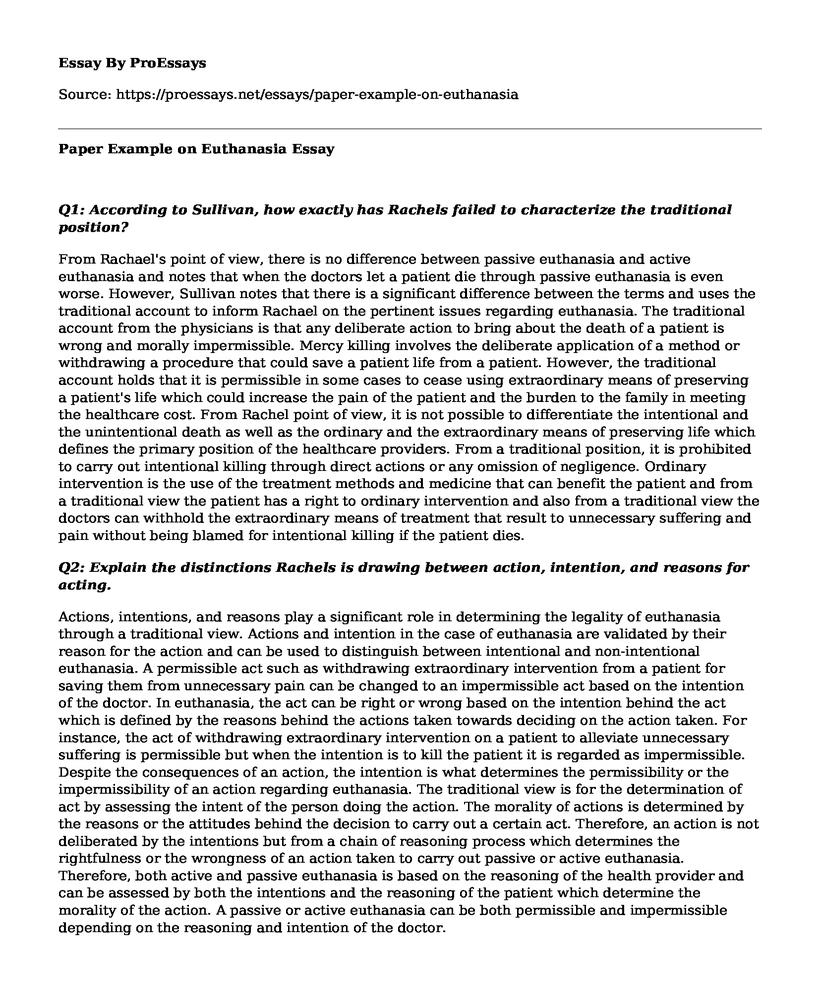Q1: According to Sullivan, how exactly has Rachels failed to characterize the traditional position?
From Rachael's point of view, there is no difference between passive euthanasia and active euthanasia and notes that when the doctors let a patient die through passive euthanasia is even worse. However, Sullivan notes that there is a significant difference between the terms and uses the traditional account to inform Rachael on the pertinent issues regarding euthanasia. The traditional account from the physicians is that any deliberate action to bring about the death of a patient is wrong and morally impermissible. Mercy killing involves the deliberate application of a method or withdrawing a procedure that could save a patient life from a patient. However, the traditional account holds that it is permissible in some cases to cease using extraordinary means of preserving a patient's life which could increase the pain of the patient and the burden to the family in meeting the healthcare cost. From Rachel point of view, it is not possible to differentiate the intentional and the unintentional death as well as the ordinary and the extraordinary means of preserving life which defines the primary position of the healthcare providers. From a traditional position, it is prohibited to carry out intentional killing through direct actions or any omission of negligence. Ordinary intervention is the use of the treatment methods and medicine that can benefit the patient and from a traditional view the patient has a right to ordinary intervention and also from a traditional view the doctors can withhold the extraordinary means of treatment that result to unnecessary suffering and pain without being blamed for intentional killing if the patient dies.
Q2: Explain the distinctions Rachels is drawing between action, intention, and reasons for acting.
Actions, intentions, and reasons play a significant role in determining the legality of euthanasia through a traditional view. Actions and intention in the case of euthanasia are validated by their reason for the action and can be used to distinguish between intentional and non-intentional euthanasia. A permissible act such as withdrawing extraordinary intervention from a patient for saving them from unnecessary pain can be changed to an impermissible act based on the intention of the doctor. In euthanasia, the act can be right or wrong based on the intention behind the act which is defined by the reasons behind the actions taken towards deciding on the action taken. For instance, the act of withdrawing extraordinary intervention on a patient to alleviate unnecessary suffering is permissible but when the intention is to kill the patient it is regarded as impermissible. Despite the consequences of an action, the intention is what determines the permissibility or the impermissibility of an action regarding euthanasia. The traditional view is for the determination of act by assessing the intent of the person doing the action. The morality of actions is determined by the reasons or the attitudes behind the decision to carry out a certain act. Therefore, an action is not deliberated by the intentions but from a chain of reasoning process which determines the rightfulness or the wrongness of an action taken to carry out passive or active euthanasia. Therefore, both active and passive euthanasia is based on the reasoning of the health provider and can be assessed by both the intentions and the reasoning of the patient which determine the morality of the action. A passive or active euthanasia can be both permissible and impermissible depending on the reasoning and intention of the doctor.
Cite this page
Paper Example on Euthanasia. (2022, May 16). Retrieved from https://proessays.net/essays/paper-example-on-euthanasia
If you are the original author of this essay and no longer wish to have it published on the ProEssays website, please click below to request its removal:
- Application for a Spine Surgery Fellowship
- HPV Vaccine Mandatory for Middle-Schoolers Paper Example
- Data-to-Wisdom Continuum Analysis Essay
- High Prevalence of Kidney Stones in Asian Jews: Essay Sample
- Essay Example on CDC's Accountability: Controlling the Spread of Hepatitis A (2017-2020)
- Paper Example on COVID-19 Pandemic: Examining National Policies in America
- Free Essay Sample on Elderly Nutrition: Challenges Posed by Loss of Teeth







